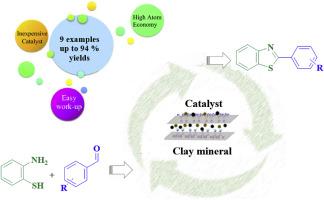将陶瓷废料转化为绿色高效苯并噻唑衍生物合成的高性能多相催化剂的创新增值
IF 3.4
4区 化学
Q2 CHEMISTRY, MULTIDISCIPLINARY
引用次数: 0
摘要
本研究介绍了一种可持续的催化剂开发策略,将陶瓷废料(特别是高岭土-石英残渣)转化为高效的多相催化剂,用于合成苯并噻唑衍生物,这是一类具有重要制药和农化价值的化合物。采用XRD、FT-IR、XRF、BET、SEM和EDX等技术对两种催化剂进行了表征。在2-氨基噻吩与多种醛的缩合反应中评估了它们的催化活性,在60分钟内以优异的收率(85 - 95%)得到目标苯并噻唑化合物。高周转率(TOF)证实了催化体系的高效率。该工艺具有多种绿色化学优势,包括催化剂负载低,反应条件温和,操作简单,产品分离容易。这两种催化剂还显示出显著的可回收性,在至少连续五个循环中保持其活性,没有明显的结构降解。通过热过滤试验证实了催化剂的非均质性,进一步支持了其在可持续多相催化中的适用性。为了定量评估环境绩效,计算了几个绿色化学指标,包括环境因子(E-factor)、原子经济性(AE)、反应质量效率(RME)、碳效率(CE)和最佳效率(OE),所有这些指标都表明了良好的生态和材料效率。总的来说,这项研究不仅推进了对环境负责的合成方法,而且促进了工业废物的循环利用。这一发现将陶瓷废料催化剂定位为具有成本效益、可回收和环保的传统系统替代品,符合当前可持续和绿色化学实践的目标。本文章由计算机程序翻译,如有差异,请以英文原文为准。

Innovative valorization of ceramic waste by transforming it into high-performance heterogeneous catalysts for green and efficient benzothiazole derivatives synthesis
This work introduces a sustainable strategy for catalyst development by repurposing ceramic waste—specifically kaolin–quartz residues—into efficient heterogeneous catalysts for the synthesis of benzothiazole derivatives, a class of compounds with significant pharmaceutical and agrochemical value. The two waste-derived catalysts were characterized using XRD, FT-IR, XRF, BET, SEM, and EDX techniques. Their catalytic activity was assessed in the condensation of 2-aminothiophenol with a variety of aldehydes, affording the target benzothiazole compounds in excellent yields (85–95 %) within 60 min. High turnover frequencies (TOF) confirmed the strong efficiency of the catalytic system.
The process exhibits multiple green chemistry advantages, including low catalyst loading, mild reaction conditions, straightforward work-up, and easy product separation. Both catalysts also showed remarkable recyclability, retaining their activity over at least five consecutive cycles with no significant structural degradation. Catalyst heterogeneity was confirmed via a hot filtration test, further supporting their applicability in sustainable heterogeneous catalysis.
To quantitatively assess environmental performance, several green chemistry metrics were calculated—including the Environmental Factor (E-factor), Atom Economy (AE), Reaction Mass Efficiency (RME), Carbon Efficiency (CE), and Optimum Efficiency (OE)—all of which indicated favorable ecological and material efficiency.
Overall, this study not only advances environmentally responsible synthetic methodologies but also promotes the circular use of industrial waste. The findings position ceramic waste-based catalysts as cost-effective, recyclable, and eco-friendly alternatives to conventional systems, aligning with current goals for sustainable and greener chemical practices.
求助全文
通过发布文献求助,成功后即可免费获取论文全文。
去求助
来源期刊
CiteScore
3.50
自引率
7.70%
发文量
492
审稿时长
3-8 weeks
期刊介绍:
The Journal of the Indian Chemical Society publishes original, fundamental, theorical, experimental research work of highest quality in all areas of chemistry, biochemistry, medicinal chemistry, electrochemistry, agrochemistry, chemical engineering and technology, food chemistry, environmental chemistry, etc.

 求助内容:
求助内容: 应助结果提醒方式:
应助结果提醒方式:


